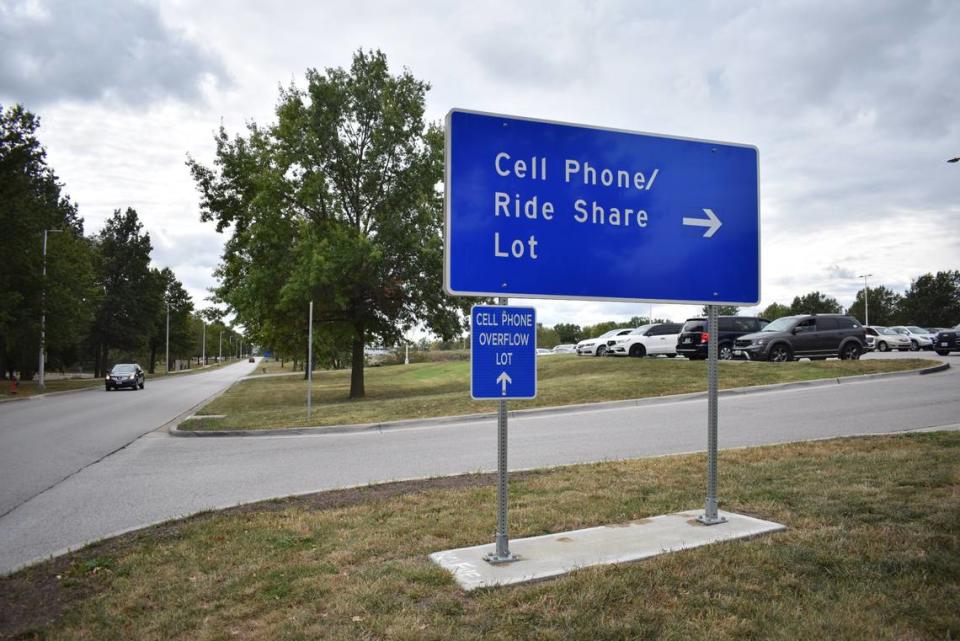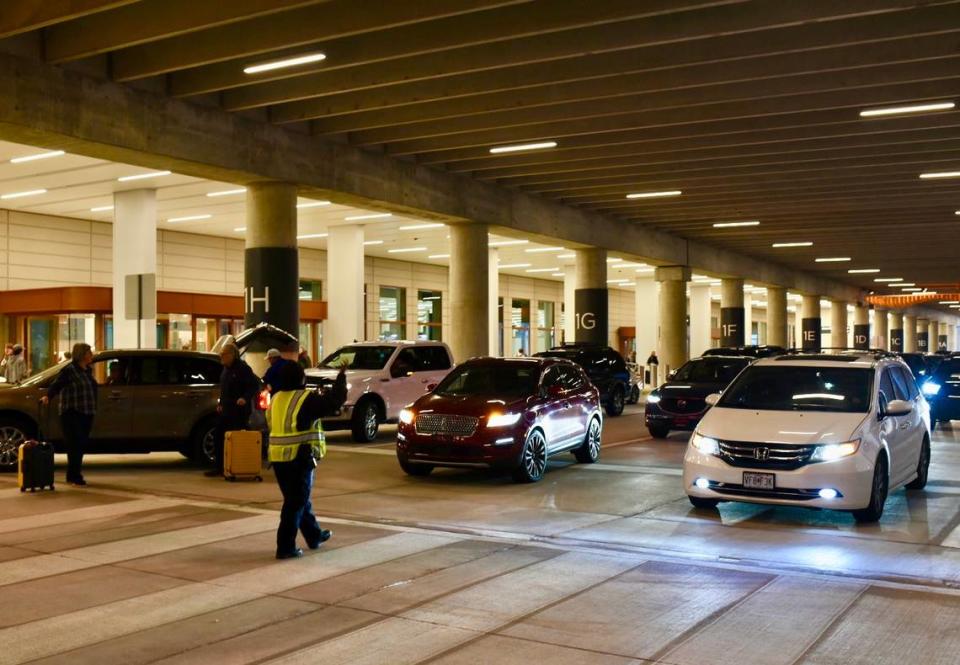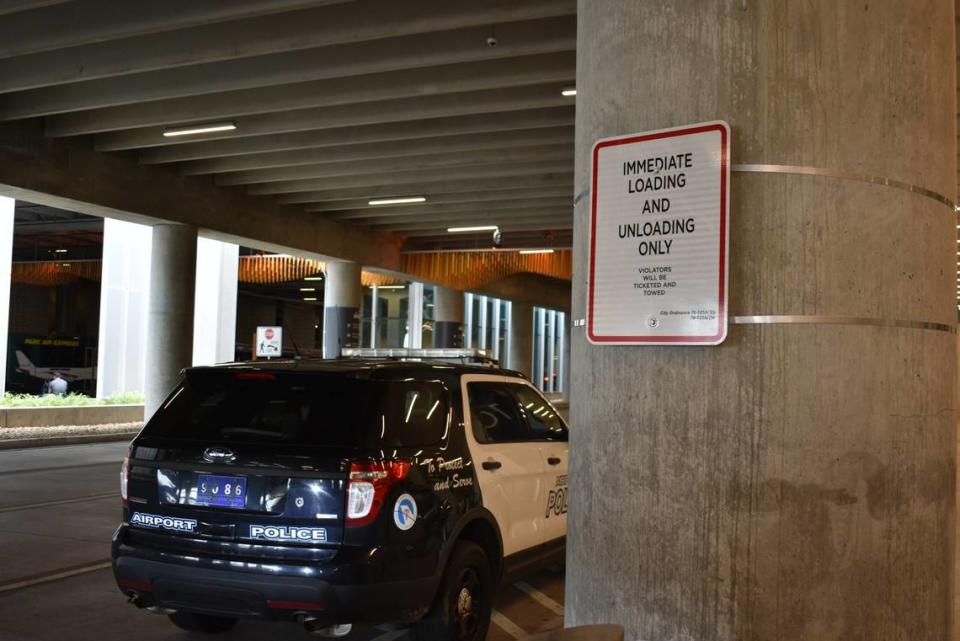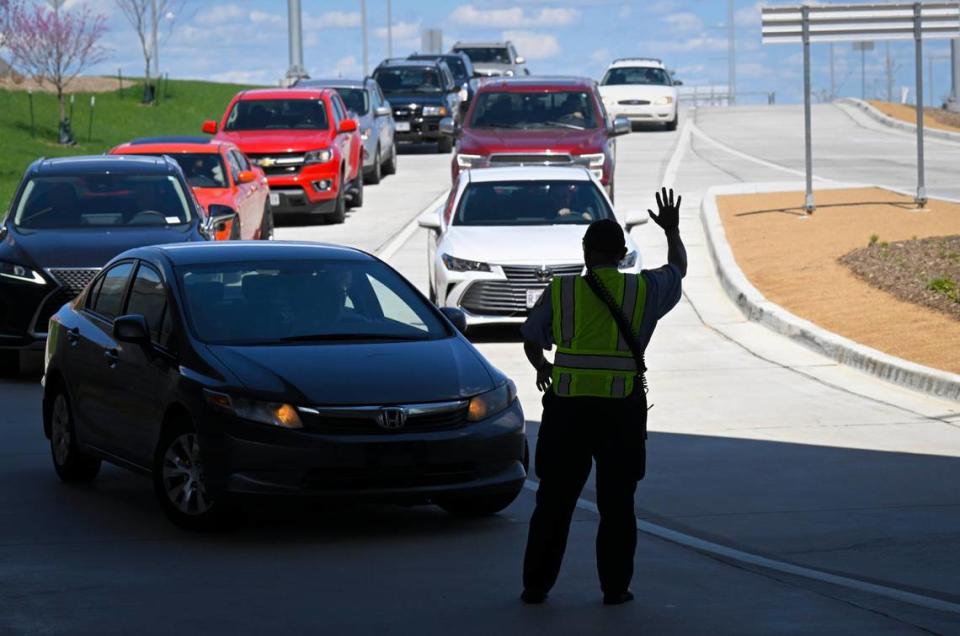‘A zoo’: Why is KCI airport still struggling with traffic at its arrivals curb?
Editor’s Note: “Reality Check” is a Kansas City Star series focused on holding those in power to their word and pulling back the curtain on decisions happening behind closed doors. This newsroom-wide project will bring fast facts as stories unfold — making sure our local officials and institutions are telling the truth, serving our communities well and following through on their promises. Have a suggestion for a future story? Email tips@kcstar.com.
Lawrence resident Jan Karlin made two trips to Kansas City International Airport last Friday to pick up her siblings — one in the early afternoon and another late at night.
Both times, she described the scene at the arrivals curb as a “zoo.”
Drivers idled three cars deep in some areas waiting for passengers while airport staff tried in vain to move traffic along. Some stopped cars would begin moving without warning, while others jockeyed to take their spot. And Karlin’s siblings — one of them over 70 years old — had to maneuver across three lanes of traffic to hop into her waiting car.
“My thought at the time — and since — is that someone is going to be hit by a car trying to get into a car picking up passengers,” Karlin said.
Seven months after the new KCI terminal opened, traffic congestion at the arrivals curb continues to be a problem. While airport officials have attempted to educate, through added signage and online resources, a public reluctant to give up old habits of idling at the curb, they admit the problem is not solved yet.
Drivers who have been to the airport recently have reported waiting in long lines to catch shuttle buses and limousines because of traffic delays and seeing drivers abandon their cars in the pickup lanes to go inside the arrivals area. Some have noted the congestion along the curb makes it harder for people using wheelchairs and motorized scooters to make their way through.
A few readers shared positive experiences, saying that their pickup was smooth — or at least no worse than at other major airports.
Airport employees told The Star that traffic control was more difficult because of persistent understaffing, forcing officials to bring in contracted help for busy times.

Meanwhile, planning documents show that, long before the new terminal opened, airport officials were aware that the new design would mean the arrivals area would not work the way it had at the old terminals.
Airport spokesperson Joe McBride said officials are working to improve the situation ahead of the holiday season.
“We’re owning it to a certain extent — we need to do better,” he said. “We’re going to see more steady activity at the arrivals curb, and we need to anticipate that and be ready.”
Congestion at arrivals
In some ways, KCI’s congestion problem was predictable nearly a year in advance.
The new terminal’s design allotted 770 linear feet of curb space at the arrivals area — just over half the 1,400 feet at each of the old terminals.
Officials also knew based on traffic modeling that the new passenger pickup area would be more difficult to navigate than the old ones.
In a 2018 planning report obtained by The Star, researchers at the engineering firm Olsson Associates gave the former terminals’ arrivals area an “A” grade for the level of service it provided travelers.
But in 2022, a projection by the aviation consulting firm Landrum & Brown gave the new arrivals area a “C” grade, with the potential for its usability to get worse during peak hours.
“Even though the level of service for this portion of the curb is acceptable, this will degrade rapidly when traffic grows beyond volumes projected in Olsson’s traffic study report,” the firm concluded.
2022 KCI Curbside Analysis by The Kansas City Star on Scribd
Before the new terminal opened, little was said to the public about the challenges of the new arrivals curb’s design and how it would mean changing habits around parking to pick up passengers.
McBride said the airport shared educational information, including virtual tour videos, on many aspects of the new terminal before it opened.
“Advance info disseminated was focused on what was new and what to expect and what was different, not studies or anticipated problems,” he said.
When the new terminal opened, Kansas City drivers accustomed to parking at the curb kept doing so. Traffic backups frustrated the people behind them.
Drivers said the signs at the new terminal were confusing and that it was not clear how many lanes went into the arrivals area.
While airport officials told drivers they could not park at the curb and urged people to use the cellphone lot, some responded that they did not know where, or even what, the cellphone lot was.
In response, the airport has introduced educational materials like added electronic signage, social media posts and YouTube videos showing how to pick passengers up, how to find the cellphone lot and how to get from there to the arrivals curb.

The crosswalk problem
Last spring, when looking ahead to the usability of the new terminal’s arrivals curb, Landrum & Brown researchers largely attributed their mediocre letter grade to the area’s two crosswalks.
“This (grade) is mainly because of large number of pedestrian crossings on the arrivals level, resulting in numerous stops for vehicles using this portion of the curbside,” researchers wrote.
That “large number” is two. Each wide crosswalk is flanked on either side by flashing yellow lights embedded into the pavement. These crosswalks are the only way for pedestrians to access the taxi, limo, shuttle and rental car lanes farther out from the terminal.

David Lee of Waldo, who visited the airport Sunday to pick up his mother, said this design creates conflict between cars trying to advance and pedestrians trying to cross the four arrival lanes to catch shuttles and buses.
“Constant foot traffic meant vehicle traffic could not advance, and it appeared to continue to back up until drivers got frustrated and tried to advance between pedestrian groups,” Lee recalled. “The design seems intensely unsafe for the pedestrians as well as inconvenient for all vehicles.”
Several airport police officers who spoke with The Star said that the crosswalks cause issues in part because drivers are not paying as close of attention to them as they would on a normal road. Instead, they are often scanning the curb or checking their phones in an attempt to locate their loved ones.
One officer said that even if the airport installed traditional traffic lights and pedestrian walk lights, drivers may still disregard them.
And while airport employees will occasionally act as crossing guards, several said that there aren’t enough workers to do so full-time — and that low staffing has been a problem since before the new terminal opened.
Traffic enforcement
Kansas City area residents have noticed the dearth of airport staff at the arrivals curb, especially during late-night pickups when many staff members aren’t working. During these hours, the airport often relies on contracted workers to maintain the flow of traffic.
During the day, the job is usually shared by two types of airport employees: traffic control officers and airport police.
Traffic control officers are airport employees who specialize in directing traffic, but also dispatch limousines and may be called on to help staff the terminal’s information desk.
Airport police officers perform a wide range of security and law enforcement duties in addition to helping direct traffic. They also write tickets, which McBride said usually go to empty parked cars rather than cooperative drivers who move their cars when asked.

Since the new terminal opened, airport police have issued at least 525 traffic tickets, of which they say “at least 99%” were written at the terminal curbs. It’s not known exactly how many have been written in the arrivals area.
But both traffic control officers and airport police said that they don’t have enough employees to properly staff the curb.
“The general consensus with the airport employees is, they need more people,” said one airport police officer, who declined to be named in this story. “The officers can be down here doing this, but if we get a firearm call at the checkpoint, or if we get an alarm call, they’ve got to leave. They can’t stay down here.”
Only traffic control officers are generally monitoring traffic during the majority of their shift — and McBride said that nine of the 22 total jobs in this position remain unfilled. These positions start at $18.61 per hour.
“We’ll have some of them that’ll come on, and then they’re here for six months, and it’s like, ‘This really sucks for what I’m getting paid,’” the airport police officer said. “’People are yelling and screaming at me, and I’ve got to be out there on my feet the entire day.’”

Clyde Kemp Jr., a traffic control officer, said that some drivers get irate when asked to move — but most understand. When he isn’t approaching idling cars, Kemp added that he will sometimes direct traffic at the crosswalks.
“Sometimes I’m a traffic stoplight,” he said. “It depends on the manpower or the womanpower.”
He and the airport police officer said that around 12 employees covering arrivals traffic on each shift would help mitigate the congestion.
“We’ve had hiring fairs recently to fill those custodial and other front line positions,” McBride said. “I think we’ve had some successes, but continue to have needs there.”
For now, the airport will continue to supplement its staff with contracted workers in order to manage the issue at the arrivals gate. McBride added that he hopes drivers will continue to adjust their behavior as the airport figures out how to mitigate the problem permanently.
“I’d ask for people to be courteous and think of others,” he said. “It’s a shared learning curve for the aviation department (and) the general public.”
The Star’s Robert A. Cronkleton contributed.
Do you have more questions about getting around Kansas City? Ask the Service Journalism team at kcq@kcstar.com.


